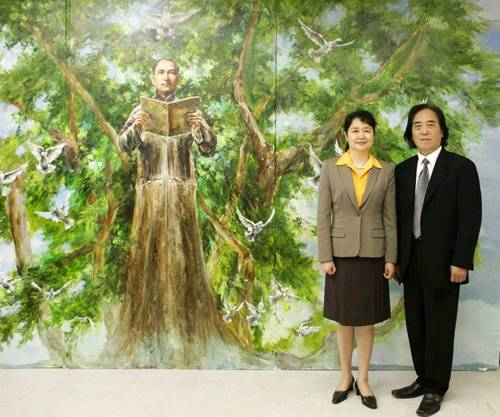Beijing (CNS) -- Xinsheng Wang's nationwide solo exhibition named "Imagery?Evaluation" is touring across Beijing, Nanjing, Shanghai and some other cities on the Chinese mainland from the beginning of July.
The recently closed Beijing exhibition displayed over 70 pieces of his ten oil painting series, including Sun Yat-sen, Tibet, Jazz Music, several portraits, as well as Chinese Zen Meditation.
According to Wang, the show is a gathering of pieces in various styles he has been working on over decades.
Motivated by the clash of Eastern and Western civilizations, he combined the "spiritual imagery" of traditional Chinese painting and the "brilliant glory" of impressionism in his creations, along with his own contemporary reflection.
In the fascinating Sun Yat-sen series, a giant three-piece painting, about 2.68m long and 4.5m wide, is full of imagery.
The enormous tree behind Sun symbolizes the wish for a prosperous future for the Chinese people. The long history of Chinese civilization and the ties among all Chinese people are embedded in the crossing branches and luxuriant leaves.
"This painting was created in a three-piece form, to bless the unity of the mainland, Taiwan, Hong Kong, and Macao," explained Wang.
"The Old Summer Palace Bronze Animal Heads Series was under the background of the 'bronze animal heads auction incident' (relics that had been looted from the Palace during the Second Opium War sold at auction abroad). The red color of the animals' eyes implies the test of blood and suffering that China has gone through. The ruins of the Old Summer Palace behind the animals show the flow of time," said Wang. "China is the original home to these looted items. I hope they will come back one day."
Wang migrated to the States in 1992. Settling down in Houston, he later founded the Wang Xinsheng Art School, and achieved great success in oil paintings and art education.
With plenty of experience in art galleries and universities across the States and Taiwan, this is his first exhibition on the Chinese mainland.
The city of Houston named March 15 "Wang Xinsheng Day" to honor his outstanding contributions to cross-cultural art communication.
Wang has paid special attention to the "neglected corner" of the U.S. Speaking of the American Grassroots series he says, "As an artist, the focus of attention should not be restricted to bright content, but also to the realities the grassroots are confronting, in order to arouse consciousness."
In his view, painting art is more than a means to express inner emotions with images. Deep thought and strong impact are also expected.
"In the Jazz Music series, I escaped the graceful jazz favored by the white-collared, and looked at the root of jazz clubs. Daily pressures are let out in their passionate music. Since then, I fell in love with jazz."
"In spite of the previous smooth-going exhibitions, I have never been so excited as this time," said Wang. "I came to share with all artists my overseas experiences, and to learn about Chinese contemporary art development. It is my strong wish that both Chinese and American artists are bridged."
"Art preserves the essence of life throughout eternity." Despite the different origins of Eastern and Western arts, mutual communication and even clashes will definitely better present the vigor of our era.
Living abroad for almost 20 years, Wang mentioned a "return flow" of Chinese people. The current age is anticipating an energetic revitalization of Chinese arts. Overseas Chinese artists, rooted in this origin, will be more inspired and nourished in the return.



















